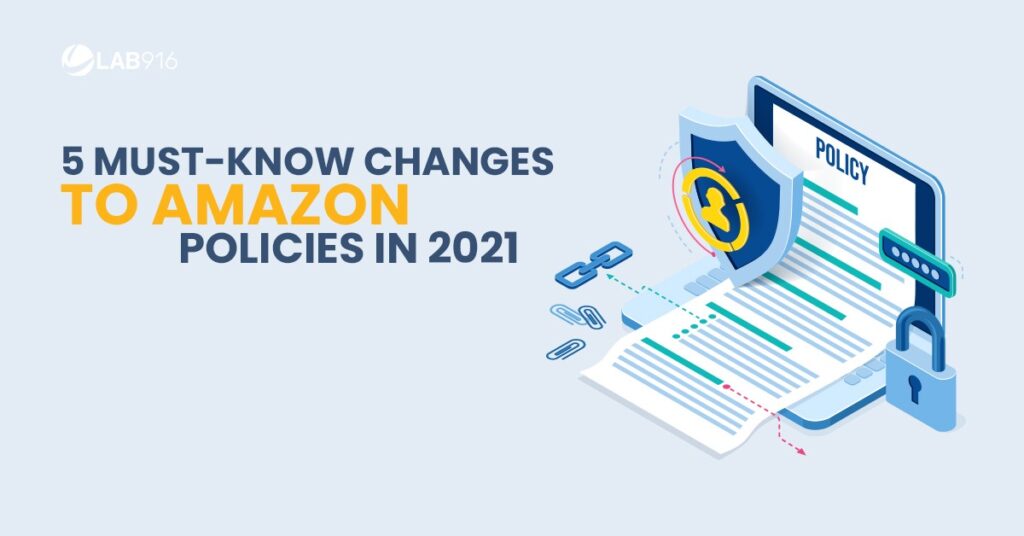As 2020 comes to an end, we feel confident that we’re speaking on everyone’s behalf when we say that we’re in no mood for surprises. In honor of transparency, here are Amazon changes, including the 5 policies and predictions that Amazon US Sellers will need to prepare for to succeed in 2021.

IPI Limits Reduced to 450
Earlier this year, Amazon reported that they are lowering the Inventory Performance Index (IPI) threshold to 450.
- Sellers with an IPI of 450 or above by mid-December will not be subject to storage volume limits.
- Sellers with an IPI of 450 or below will be held to storage volume limits for standard-size, oversize, apparel, and footwear items.
Previously, your IPI score was calculated based on factors like excess inventory, sell-through, stranded inventory, and in-stock inventory.
Starting January 1, 2021 IPI will be based on time duration which, allegedly, results in a higher score. The calculation change benefits sellers with lower sales volume in their off-peak season as well as sellers taking action to improve their inventory performance.
If you’re a seller that’s negatively impacted by this new policy, consider other fulfillment methods such as Fulfillment By Merchant, Seller Fulfilled Prime, or Third-Party Storage & Fulfillment.
Amazon Fee Changes Are On Hold Until June 1, 2021
Every year, Amazon announces fee changes that take effect around February.
However, just before Christmas, Amazon’s Worldwide Consumer CEO Jeff Wilke, announced Amazon will be postponing its logistics fee increases until June 1, 2021 to support businesses affected by the pandemic.
More details on fee changes are expected to surface this spring.
Changes to Seller Fulfilled Prime for US Sellers
This holiday season, many Sellers have had to pay for refunds for delayed USPS packages. Although logistics have been a sore spot for non-FBA sellers, Amazon has announced additional updates to Seller Fulfilled Prime (SFP) in order to “improve delivery speed” for Prime customers regardless of who fulfills the order.
Amazon states that these required changes will go into effect February 1, 2021:
- Have nationwide delivery coverage for all standard-size products on Prime enabled shipping templates
- Meet targets for one-day and two-day delivery promises
- Use ship methods that support Saturday delivery and pickups to provide customers with a more consistent delivery experience throughout the week
Saturday deliveries and pickups can be pricey for hands-on small business owners. And, with all of the shipping delays, even partner carriers like USPS aren’t meeting delivery promises.
With this new policy in place, Lab 916 experts urge Sellers will have to calculate if SFP still makes sense for their operations.
It’ll Be Harder to Sell On Amazon
As we’ve seen this year, new product restrictions and unprompted suspensions have become Amazon’s go-to automated response to remove potential counterfeit or price-gouged products sold by third-party Sellers.
In a written testimony from Robert C. Barchiesi of the International AntiCounterfeiting Coalition, he states, “As one of the largest and most influential ecommerce companies in the world, Amazon has an important role to play in ensuring that counterfeit goods stay out of consumers’ hands.”
Suffice to say, Amazon now has a fire lit under them to expect more from Sellers.
One way Amazon has already demanded more is their new policy on dietary supplements, announced just after Prime Day, which requires Sellers to prove their products have been tested and meet specific standards.
This is undoubtedly a necessary and good step to protect customers from purchasing products that may harm them. However, it creates a few new hoops for legitimate brands to jump through before selling on Amazon.
Because all eyes are on the e-commerce giant, we don’t think they’ll be stopping at health and wellness products. It will get harder for no-name brands without a presence outside of Amazon to succeed.
Brand Registry Becomes More Important
Although it will be harder for brands without a trademark to succeed on Amazon, brand owners that have brand registry will greatly benefit from all of the new brand tools.
With all of the new brand tool releases and updates that happened in the past few years, it’s easier than ever for brands to connect with customers and sell more.
Things like Video in Sponsored Brands, Sponsored Brands Image, Brand Stories, Amazon Posts, and more, will allow Sellers to track the impact of their efforts. These brand tools will also allow small, medium, and large businesses to create their own custom experience for Amazon shoppers.
Additionally, we wouldn’t be surprised if brand registered Sellers will have the ability to approved sellers to prevent hijackers and counterfeits from applying branded listings to their phony products.
Likewise, only Amazon Vendors have access to premium A+ Content modules as of now. Our experts expect the premium, A+ content video modules to be available to brand registered Amazon Sellers soon, as Amazon Advertising has determined that videos are one of the most effective types of content.


